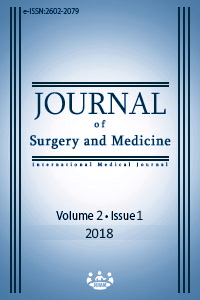Evaluation of increased high-sensitivity cardiac troponin in patients with radiofrequency ablation
Keywords:
High-sensitivity troponin, Radiofrequency ablation, Emergency serviceAbstract
Aim: In our study; we explored which ablation parameter is mostly associated with the increased high-sensitivity troponin tests (hs-cTnT) in patients undergone radiofrequency ablation (RFA).
Methods: We included patients who underwent RFA within the previous year, and later admitted to emergency service with chest pain to our study. ECG and echocardiographic examination were performed before the electrophysiological study (EPS) for all patients. After RFA, information regarding the total duration, energy and mean temperature was recorded. Blood samples were collected via venous route from patients who underwent RFA, and later admitted to emergency service with chest pain to study hs-cTnT.
Results: There were 119 patients [38 males, median age 51years (IQR:29)] included in our study. 6 of them (80.7%) were detected to have atrioventricular nodal re-entrant tachycardia (AVNRT), 14(11.8%) Wolff Parkinson White Syndrome (WPW), and 9 (7.5%) Right Ventricular Outflow Tract (RVOT) Tachycardia. Hs-cTnT and total RFA duration (r=0.683,p<0.001), total energy (r=0.423, p<0.001) and mean temperature (r=0.371, p<0.001) were correlated. In linear regression analysis; total RFA duration (OR:0.842, 95% CI: 0.685-0.999, p<0.001) and mean temperature (OR:10.738, 95% CI: 6.420-15.055, p<0.001) were detected to be independent predictors for hs-cTnT.
Conclusion: This study has shown us that it should be noted that patients who underwent RFA for a prolonged duration and at high temperature may admit to the emergency service with chest pain, therefore, their troponin levels may increase, and also in these patients no further work-up or treatment would be required.
Downloads
References
Calkins, H., Yong, P., Miller, J. M., et al. Catheter ablation of accessory pathways, atrioventricular nodal reentrant tachycardia, and the atrioventricular junction: final results of a prospective, multicenter clinical trial. The Atakr Multicenter Investigators Group. Circulation. 1999;19(99):262–270.
Page RL, Joglar JA, Caldwell MA, et al. 2015 ACC/AHA/HRS guideline for the management of adult patients with supraventricular tachycardia: A Report of the American College of Cardiology/American Heart Association Task Force on Clinical Practice Guidelines and the Heart Rhythm Society. Heart Rhythm. 2016;13:136-221.
Zhelev Z, Hyde C, Youngman E, et al. Diagnostic accuracy of single baseline measurement of Elecsys Troponin T high-sensitive assay for diagnosis of acute myocardial infarction in emergency department: systematic review and meta-analysis. BMJ. 2015;20;350:h15.
Carlton E, Kendall J, Khattab A, et al. Low Concentrations of High-Sensitivity Troponin T at Presentation to the Emergency Department. Clin Chem. 2017;63:431-432
Omland T, de Lemos JA, Sabatine MS, et al. Prevention of Events with Angiotensin Converting Enzyme Inhibition (PEACE) Trial Investigators. A sensitive cardiac troponin T assay in stable coronary artery disease. N Engl J Med. 2009 24;361:2538-2547
Alaiti MA, Maroo A, Edel TB. Troponin levels after cardiac electrophysiology procedures: review of the literature. Pacing Clin Electrophysiol. 2009;32:800-810.
Hakan Duman, Ziya Şimşek, M. Hakan Taş, et al. Effects of radiofrequency ablation on levels of cardiac biochemical markers in patients with atrioventricular nodal re-entry tachycardia. Anadolu Kardiyol Derg. 2013;13:705-707.
Emkanjoo Z, Mottadayen M, Givtaj N, et al. Evaluation of post-radiofrequency myocardial injury by measuring cardiac troponin I levels. International Journal of Cardiology. 2007;117:173–177.
Katritsis D, Hossein-Nia M, Anastasakis A, Poloniecki I. al. Use of troponin-T concentration and kinase isoforms for quantitation of myocardial injury induced by radiofrequency catheter ablation. European Heart Journal. 1997;18:1007-1013.
Reichlin T, Lockwood SJ, Conrad MJ, et al. Early release of high-sensitive cardiac troponin during complex catheter ablation for ventricular tachycardia and atrial fibrillation. J Interv Card Electrophysiol. 2016;47:69-74.
Vasatova M, Pudil R, Tichy M, et al. High-sensitivity troponin T as a marker of myocardial injury after radiofrequency catheter ablation. Ann Clin Biochem. 2011; 48: 38-40.
Schueler M, Vafaie M, Becker R, et al. Prevalence, kinetic changes and possible reasons of elevated cardiac troponin T in patients with AV nodal re-entrant tachycardia. Acute Card Care. 2012;14:131-137.
Costabel JP, Urdapilleta M, Lambardi F, et al. High-Sensitivity Cardiac Troponin Levels in Supraventricular Tachyarrhythmias. Pacing Clin Electrophysiol. 2016;39:588-591.
Ben Yedder N, Roux JF, Paredes FA. Troponin elevation in supraventricular tachycardia: Primary dependence on heart rate. Can J Cardiol. 2011;27:105–109.
Casella M, Dello Russo A, Russo E, et al. Biomarkers of myocardial injury with different energy sources for atrial fibrillation catheter ablation. Cardiol J. 2014;21:516-523.
Herrera Siklódy C, Arentz T, Minners J, et al. Cellular damage, platelet activation, and inflammatory response after pulmonary vein isolation: a randomized study comparing radiofrequency ablation with cryoablation. Heart Rhythm. 2012;9:189-196
Han SW, Shin SY, Im SI, et al. Does the amount of atrial mass reduction improve clinical outcomes after radiofrequency catheter ablation for long-standing persistent atrial fibrillation? Comparison between linear ablation and defragmentation. Int J Cardiol. 2014;171:37-43.
Parwani AS, Boldt L-H, Huemer M, et al. Atrial fibrillation-induced cardiac troponin I release. Int J Cardiol. 2013;168:2734–2737.
Downloads
- 498 714
Published
Issue
Section
How to Cite
License
Copyright (c) 2018 Yahya Kemal İçen, Mevlüt Koç
This work is licensed under a Creative Commons Attribution-NonCommercial-NoDerivatives 4.0 International License.















